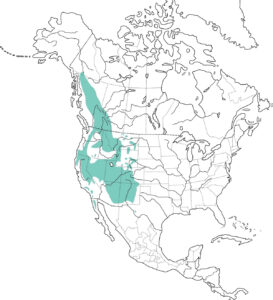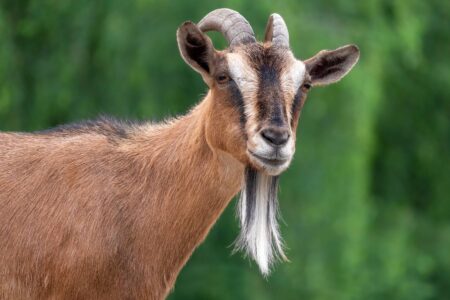Chickadee populations are doing well in North America, in part because these diminutive birds have adapted remarkably well to extreme weather conditions. The closely related black-capped, Carolina, and mountain chickadees are the most widespread of the seven chickadee species found on the continent, and most are nonmigratory, meaning they’ll stay nearby for all four seasons.

The black-capped chickadee is found coast to coast throughout the northern two-thirds of the United States, and into Alaska and Canada. Carolina chickadees reside in the southeastern United States, but are expanding northward. Mountain chickadees live in the high-elevation coniferous forests of southern Arizona, Baja California, British Columbia, and the Yukon. Wherever these species overlap, they can hybridize.


A flock of chickadees is called a “banditry,” after the mask-like appearance of the birds’ head feathers. To identify which chickadee species has taken up residence on your land, note that the 5-inch-long black-capped chickadee has a wingspan of 8 inches, a relatively long tail, black cap and bib, and large, white cheek patches. Similar in appearance, Carolina chickadees are slightly smaller. Mountain chickadees sport a white stripe over the eyes.
All three of these chickadee species produce a “chick-a-dee-dee-dee” or “dee-dee-dee” call with slight variations. The black-capped chickadee sings a clear, plaintive “fee-be-be” or “fee-bee,” with the first note higher in tone than the following. The Carolina sings three to five varying notes that sound like “see bee see bay.” Mountain chickadee songs are longer than the black-capped’s.
In warm weather, chickadees consume large amounts of insects and spiders. Chickadees survive cold winters by gathering insects, seeds, and berries, and consuming as many calories by day as they lose by night. Black-capped chickadees may cache hundreds of seeds daily, and will remember their cache locations for weeks. Although chickadees are conspicuous at backyard feeders, these foods comprise only a fifth of their diet.
How to Snag Chickadees


Bird lovers can attract native chickadee species to their backyards fairly easily. Stock your feeders in winter with black oil sunflower seeds and suet to enhance chickadee survival. Plant willow, alder, and birch trees to provide future nesting habitat. Chickadees also use “starts” to excavate nesting cavities. Both parents will excavate a 6-to-8-inch-deep nest cavity in a tree snag, or use abandoned woodpecker holes or bluebird nest boxes. You can help them by drilling 11⁄8-inch-diameter holes in dead forest trees. The nest can fill the entire cavity, and will be made of moss, pine needles, and strips of bark; it’ll be lined with softer plant fibers and animal hair. The females will lay one egg per day, in the morning, and usually average 6 to 8 eggs total. Eggs are white with reddish spots. The female incubates the eggs from 11 to 13 days. Both parents feed their chicks, which fledge 14 to 18 days after hatching.
All seven chickadee species are likely to accept nest boxes or artificial “tree snags” made from PVC tubes or wood, especially where natural nest sites are rare. Mount the nest boxes by early February in the South, and by April elsewhere, hanging them on metal or wooden poles outfitted with predator guards. Hanging the nest boxes directly on a favorite chickadee tree may also increase nesting success. Fill the boxes with wood chips up to the level of the entry hole before breeding season begins. These birds prefer shady areas in woodlands with open spaces, although they also find suburban areas acceptable.
Make sure you hang the nest boxes at a height that permits you to check them easily. Clean out your nest boxes in fall and spring. Note that chickadees will use nest boxes for roosting during cold winter nights.
DIY Chickadee Nest Box
Ohio State University researchers Tom Grubb and Cindy Bronson tested artificial chickadee nest structures they called “snags” in central Ohio in the 1990s. These were 10-foot-tall, 4-inch-diameter PVC tubes that came to be called “Grubb stakes.” Ten years later, researchers at the Cornell Lab of Ornithology discovered that upstate New York chickadees nested more often in PVC snags filled with wood chips than in typical square wooden nest boxes.
Chickadees may like the snag design because its high entrance hole is less accessible to mice and predators. Canadian chickadee researchers Ken Otter and Daniel Mennill shortened the Grubb stake to about 14 inches for easier use in the field. Later, woodworker Chris Willett created the following wooden version in response to concerns about moisture levels inside the tube, as well as environmental concerns about PVC.
Materials List
- 1x4x37-1/4-inch cypress board
- 1x6x31-1/4-inch cypress board
- 2x4x4-inch cypress board
- 1x8x6-1/2 inch cypress board
- 2-inch exterior-grade deck screws (30)
- 1-1/4-inch exterior-grade deck screws (4)
- 2-1/2-inch galvanized finish nails (3)
- Vinyl-coated wire rope
- Light-colored, water-based exterior stain (optional)

1. From the cypress boards, cut two 3-by-15-1/2-inch 1/2 pieces for the front and back; two 4-1/2-by-15-1/2-inch pieces for the sides; one 6-1/2-inch square for the main roof; two 3-inch squares for the inner roof and floor; and two 1-1/2-by-4-inch mounting blocks. Use the illustration (above) as a cutting guide.
On the front piece, center and drill a 1-1/8-inch-diameter entry hole, again referring to the illustration. Also on the front piece, make 1/4-inch-deep kerf cuts on what will be the front interior; make these cuts every 1/2 inch, from the bottom to just below the entry hole, and ending 3/8 inch from the edges. On the side pieces, cut 45-degree bevels on the long edges, and set aside the four resulting bevel castoffs to use later as 13-inch-long interior corner supports. Predrill both mounting blocks with centered 1/2-inch-diameter holes, and refer to the illustration to cut off angled pieces from one end. Predrill all holes to avoid splitting wood, and countersink all screws.

2. Position inner supports 3/4 inch below the top edge of the front and back pieces (this creates a space for the inner roof), and 1 inch up from the bottom (to allow room for the recessed floor). Attach the supports with 1-inch brads in a pneumatic nailer, or hammer in 1-inch nails by hand.

3. Attach the mounting blocks through the back piece from what will become the inside of the nest chamber. Predrill holes and use four 2-1/2-inch screws on each block.
4. Referring to the illustration, assemble the nest chamber by predrilling and attaching the sides to the front and back pieces.

5. Make kerf cuts on the underside of the main roof piece; as with the front piece, make these kerfs 1/4-inch-deep and ending 3/8 inch from the edges. Mark where the inner roof will be attached, equal distance from the outside edges. Predrill carefully, making sure to not pierce all the way through the main roof. Attach the inner roof to the main roof with the 1-1/4-inch exterior-grade deck screws. Set the inner roof into the nest chamber, sanding the edges slightly if necessary to make it fit. Make a distinguishing mark toward the front to aid you in aligning the roof in the future. Use a 1/8-inch drill bit to drill through the two sides and the front into the inner roof. These holes are for bent-head 2-1/2-inch galvanized finish nails that will secure the roof to the nest chamber. Install the floor with 2-inch screws, predrilling the holes and recessing the floor about 3/8 inch from the bottom. As with the inner roof, the floor piece may have to be sanded slightly to fit. Optionally, you can drill a few 1/4-inch drain holes in the nest box floor.
6. Using a 1/8-inch drill bit, drill holes through the two sides and the front into the inner roof. Install 2-1/2-inch galvanized finish nails, with heads bent at a 90-degree angle, to serve as latch nails. These homemade latch nails will make roof removal easy. Thread vinyl-coated wire rope through mounting blocks and attach clasps. Optionally, you can protect the exterior of the nest box with a coating of light-colored, water-based exterior stain.

This is excerpted from the Audubon Birdhouse Book, Revised and Updated: Building, Placing, and Maintaining Great Homes for Great Birds (Cool Springs Press) by Margaret A. Barker, Elissa Ruth Wolfson, and the National Audubon Society.
Attract more avian friends to your property by Growing and Making a Gourd Birdhouse.

Victorian Birdhouse Plans
Backyards are a great place to host parties, play games, or relax after a day’s work. With backyard project e-plans, such as with this Victorian bird house, you can build whatever you need to create your dream backyard. You’ll receive plans to build a 13-1/2-by-11-1/4-by-17-3/4-inch bird house, a complete list of building materials, and step-by-step instructions to construct an elegant shelter. Don’t wait for delivery, or pay an expensive shipping and handling fee: Order this e-plan and it’ll be delivered directly to your computer. For best results, print at 100 percent on 11×17-inch paper, or have the plan printed at your nearest print store.
Available at Store.Grit.com or by calling 866-803-7096. Item #5184.








